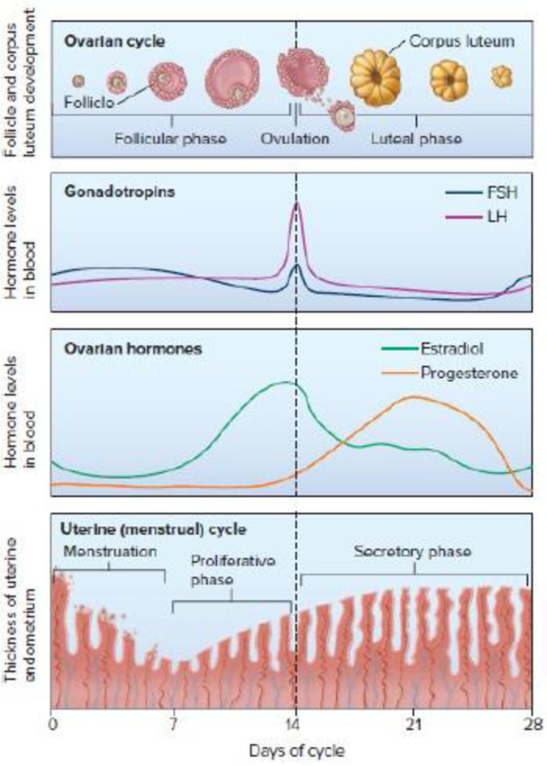
Core Skill: Connections In what other context have you learned about positive feedback? Refer back to Figures 51.9 and 51.11 for help.

Figure 51.9 The ovarian and uterine cycles in a human female. The ovarian cycle is divided into the follicular and luteal phases. The uterine cycle is divided into menstruation and the proliferative and secretory phases.

Figure 51.11 Hormonal control of parturition. Birth relies on neural signals from the uterus and maternal hormones that act on the uterus. In response to sensory neural input arising from the push of the fetus on the cervix, the maternal posterior pituitary releases oxytocin into the blood, which stimulates uterine smooth muscle contractions. The secretion of prostaglandins by the uterus also increases the strength of the contractions. Sensory receptors in the uterus detect the more forceful contractions and signal the mother's posterior pituitary to secrete more oxytocin, thus completing a positive feedback loop that further strengthens the contractions.
Want to see the full answer?
Check out a sample textbook solution
Chapter 53 Solutions
BIOLOGY (LL)
- irections: Read each statement or question below carefully and fill in the blank(s) with the correct answer. 1 Refers to the series of changes that occur in sexually mature, non-pregnant formales which culminates into menses. 2. The secretos a hormone that stimulates the egg cells in the ovaries to grow 3. High level of progesterone produces .a hormone associated with anxiety and stress. _4. It is the abitity to become fertile or to produce an offspring _5. A system that consists the brain and the spinal cord. 6. It consists of 10 billion neurons that control everything a person does, such as thoughts, movernents, memory, and sense 10arrow_forwardWhat's More Concept Mapping: Fill-in the concept map of egg release (start with the ovary). Use the following statements to guide you in answering the activity. Ovary Ovary Releases an egg in a process called The exact location of egg cell to meet the sperm. The fertilized egg will be deposited to the If the egg is not fertilized, the uterine Walls lough off and blood comes out in the process called If egg is fertilized it is calledarrow_forwardMale and Female Reproduction, Fertilization, and Development Try NOT to use your slides! Word Bank: Reproduction Reproductive System Sperm Menstruation Fertilization Testes Blastula Cervix Penis Eggs Urethra Prostate gland Cleavage Vagina Uterus Scrotum Vas deferens Semen Fetus Zygote Differentiation Ovaries Hormones are proteins that are made in one part of the body that affect the activities in another part of the body. The is the baglike structure that holds the testes and epididymis. The is the organ that sperm passes through as it leaves the body. are thin tubes that the sperm travel through as they pass from the epididymis to The the penis. are the organs that produce and store millions of sperm. is a structure located inside the penis that carries urine and sperm to the In males, the outside of the body. is the fluid that transports sperm cells. are female reproductive cells. are male reproductive cells, while The or birth canal is the muscular tube leading from the external…arrow_forward
- Give what is asked on the pointed areas of the ovary of a humanarrow_forwardREPRODUCTIVE ANATOMY Exercise 15 Label, Color, and Discuss an Avian Reproduction System Using colored pencils, label and shade in the following structures: ovary, infundibulum, magnum, isthmus, uterus, and vagina.arrow_forwardRecall what you learned in class about the experiments that examined the effect of early treatment with hormones on adult reproductive behavior. Match the following behavioral outcomes with each of the manipulations in the questions below. Each answer may be used more than once. An XY animal is castrated (gonadectomized) at birth and treated with testosterone the same day and the next day. What reproductive behavior, if any will this animal show when treated with testosterone as an adult? An XY animal is castrated (gonadectomized) at birth and treated with estradiol the same day and the next day. What reproductive behavior, if any will this animal show when treated with estradiol and progesterone as an adult? An XX animal is not surgically manipulated, but is treated with testosterone on the day of its birth and the day…arrow_forward
- State and explain 5 effects of tobacco smoking by a pregnant mother on the foetus development. (400 words) Identify and explain 5 disadvantages of In vitro fertilisation (IVF) as an intervention to have a baby. (400 words) Why is breast feeding in the first 3month of a baby very important? (200 words) Higher animals undergo sexual reproduction despite its complexity, why. Give 5 reasons. (400 words) Describe five changes that occur in a flower after fertilisation. (200 words)arrow_forwardThe increased release of progesterone by the corpus luteum inhibits (decreases) the release of FSH and LH. Based on your knowledge of the menstrual cycle, what will be the effect of this feedback loop?arrow_forwardBased on the schematic below, illustrating the control of the hypothalamus and the pituitary gland by the ovarian hormones, how would you design a hormonal female contraceptive that keeps secretion of FSH and LH low in order to prevent ovulation?arrow_forward
 Biology 2eBiologyISBN:9781947172517Author:Matthew Douglas, Jung Choi, Mary Ann ClarkPublisher:OpenStax
Biology 2eBiologyISBN:9781947172517Author:Matthew Douglas, Jung Choi, Mary Ann ClarkPublisher:OpenStax Biology (MindTap Course List)BiologyISBN:9781337392938Author:Eldra Solomon, Charles Martin, Diana W. Martin, Linda R. BergPublisher:Cengage Learning
Biology (MindTap Course List)BiologyISBN:9781337392938Author:Eldra Solomon, Charles Martin, Diana W. Martin, Linda R. BergPublisher:Cengage Learning


